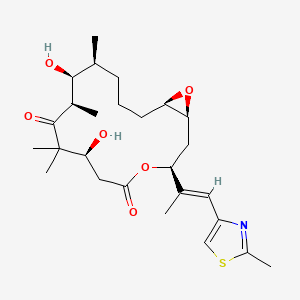| MeSH term | MeSH ID | Detail |
|---|---|---|
| Adenocarcinoma | D000230 | 166 associated lipids |
| Neoplasms | D009369 | 13 associated lipids |
| Lung Neoplasms | D008175 | 171 associated lipids |
Epothilone A
Epothilone a is a lipid of Polyketides (PK) class. Epothilone a is associated with abnormalities such as abnormal fragmented structure and Hyperostosis, Diffuse Idiopathic Skeletal. The involved functions are known as Polymerization, Mutation, Depolymerization, Musculoskeletal torsion, function and Negative Regulation of Microtubule Depolymerization. Epothilone a often locates in Microtubules, soluble, Nuclear Structure and Microtubule cytoskeleton. The associated genes with Epothilone A are C9 gene, SLC33A1 gene, KIF2C gene and HMHA1 gene.
Cross Reference
Introduction
To understand associated biological information of Epothilone A, we collected biological information of abnormalities, associated pathways, cellular/molecular locations, biological functions, related genes/proteins, lipids and common seen animal/experimental models with organized paragraphs from literatures.
What diseases are associated with Epothilone A?
Epothilone A is suspected in and other diseases in descending order of the highest number of associated sentences.
Related references are mostly published in these journals:
| Disease | Cross reference | Weighted score | Related literature |
|---|
Possible diseases from mapped MeSH terms on references
We collected disease MeSH terms mapped to the references associated with Epothilone A
PubChem Associated disorders and diseases
What pathways are associated with Epothilone A
There are no associated biomedical information in the current reference collection.
PubChem Biomolecular Interactions and Pathways
Link to PubChem Biomolecular Interactions and PathwaysWhat cellular locations are associated with Epothilone A?
Visualization in cellular structure
Associated locations are in red color. Not associated locations are in black.
Related references are published most in these journals:
| Location | Cross reference | Weighted score | Related literatures |
|---|
What functions are associated with Epothilone A?
Related references are published most in these journals:
| Function | Cross reference | Weighted score | Related literatures |
|---|
What lipids are associated with Epothilone A?
There are no associated biomedical information in the current reference collection.
What genes are associated with Epothilone A?
Related references are published most in these journals:
| Gene | Cross reference | Weighted score | Related literatures |
|---|
What common seen animal models are associated with Epothilone A?
There are no associated biomedical information in the current reference collection.
NCBI Entrez Crosslinks
All references with Epothilone A
Download all related citations| Authors | Title | Published | Journal | PubMed Link |
|---|---|---|---|---|
| Borrelli S et al. | New class of squalene-based releasable nanoassemblies of paclitaxel, podophyllotoxin, camptothecin and epothilone A. | 2014 | Eur J Med Chem | pmid:25084144 |
| Parajuli P et al. | Enzymatic synthesis of lactosylated and sialylated derivatives of epothilone A. | 2016 | Glycoconj. J. | pmid:26852037 |
| Ranade AR et al. | Characterizing the Epothilone Binding Site on β-Tubulin by Photoaffinity Labeling: Identification of β-Tubulin Peptides TARGSQQY and TSRGSQQY as Targets of an Epothilone Photoprobe for Polymerized Tubulin. | 2016 | J. Med. Chem. | pmid:26986898 |
| Rogalska A et al. | Effects of Epothilone A in Combination with the Antidiabetic Drugs Metformin and Sitagliptin in HepG2 Human Hepatocellular Cancer Cells: Role of Transcriptional Factors NF-κB and p53. | 2016 | Asian Pac. J. Cancer Prev. | pmid:27039825 |
| Jiménez VA et al. | Molecular modeling study on the tubulin-binding modes of epothilone derivatives: Insight into the structural basis for epothilones activity. | 2017 | Chem Biol Drug Des | pmid:28632973 |
| Rogalska A et al. | Metformin and epothilone A treatment up regulate pro-apoptotic PARP-1, Casp-3 and H2AX genes and decrease of AKT kinase level to control cell death of human hepatocellular carcinoma and ovary adenocarcinoma cells. | 2018 | Toxicol In Vitro | pmid:29117515 |
| Bollag DM et al. | Epothilones, a new class of microtubule-stabilizing agents with a taxol-like mechanism of action. | 1995 | Cancer Res. | pmid:7757983 |
| Gerth K et al. | Epothilons A and B: antifungal and cytotoxic compounds from Sorangium cellulosum (Myxobacteria). Production, physico-chemical and biological properties. | 1996 | J. Antibiot. | pmid:8698639 |
| Service RF | Tumor-killer made; how does it work? | 1996 | Science | pmid:8984658 |
| Mann J | Myxobacterial bounty. | 1997 | Nature | pmid:8990108 |
| Kowalski RJ et al. | Activities of the microtubule-stabilizing agents epothilones A and B with purified tubulin and in cells resistant to paclitaxel (Taxol(R)). | 1997 | J. Biol. Chem. | pmid:8999970 |
| Cowden CJ and Paterson I | Synthetic chemistry. Cancer drugs better than taxol? | 1997 | Nature | pmid:9153384 |
| Nicolaou KC et al. | Synthesis of epothilones A and B in solid and solution phase. | 1997 | Nature | pmid:9153390 |
| Taraschi TF et al. | Plasmodium falciparum: characterization of organelle migration during merozoite morphogenesis in asexual malaria infections. | 1998 | Exp. Parasitol. | pmid:9562421 |
| Finney NS | Enantioselective epoxide hydrolysis: catalysis involving microbes, mammals and metals. | 1998 | Chem. Biol. | pmid:9571210 |
| Sinha SC et al. | The antibody catalysis route to the total synthesis of epothilones. | 1998 | Proc. Natl. Acad. Sci. U.S.A. | pmid:9843936 |
| Sefkow M et al. | Oxidative and reductive transformations of epothilone A. | 1998 | Bioorg. Med. Chem. Lett. | pmid:9873669 |
| Sefkow M et al. | Derivatization of the C12-C13 functional groups of epothilones A, B and C. | 1998 | Bioorg. Med. Chem. Lett. | pmid:9873670 |
